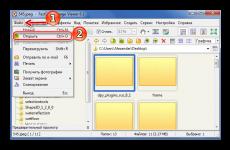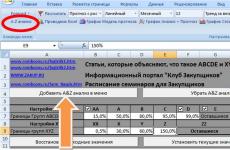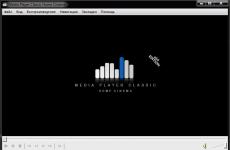Drywall thickness and other important nuances of choice. How thick should drywall be? Which hl is better for partitions
For interior decoration during the event repair work widely used material such as drywall, which is often called dry plaster. Due to the fact that the special mortar enclosed between special cardboard or paper, it is very convenient to carry out interior decoration with such material. For wall decoration, drywall sheets with a thickness of 12.5 mm are most often used, the so-called GKL wall sheets. But if it is required not only to level the walls, but also to make sound insulation at the same time, they use gypsum boards, the so-called acoustic ones, which are slightly thicker and have a porous structure. Also take into account in which room it will be used. For normal interior decoration walls fit traditional drywall with the usual thickness, and for the ceiling or for organizing arches and other structures, other types with greater or lesser thickness are needed.
Depending on the surface for which gypsum boards, they differ in marking, size and thickness. Traditional drywall boards, which are used for wall mounting, are produced with a thickness of 12.5 mm, and their dimensions are from 60 cm to 1 m 20 cm wide, and the length varies from 2 meters to 4 meters.

But most often when decorating rooms, sheet sizes are used from 2.5 meters long to 3 m 30 cm, and the width of the GKL sheet is 1 m 20 cm. Such sheets are convenient to transport and move around the room. They don't have a lot of weight.
Yes, and working with such sheets is also quite simple. In some construction stores you can find sizes of sheets and small formats, for example, such as 1 m 20 cm long and 60 cm wide. With such plates, you can even work with a finisher alone, as the light weight allows you to do this.
The thickness of drywall for the wall used in interior decoration
If you could not find such small sheet sizes, then it's okay, you can cut large sheets of plasterboard using a special knife into required dimensions that are comfortable to work with.

- For finishing ceilings, plates with a thickness of 6 mm - 6.5 mm are used, and such plates are also used for mounting any complex curved structures;
- In some cases, to save money, you can use gypsum boards 9.5 mm thick for wall decoration;
- Sound insulation also depends on the thickness of the drywall sheet, the thicker the GKL sheet, the better the sound insulation will be.
In any case, the choice of sheet thickness depends on each specific conditions, premises and scope of work performed. And also from the requirements that apply to the room in which gypsum boards will be installed.
Wall drywall: characteristics
To finish the walls in the premises, traditional drywall is used, 12.5 mm thick, but if you plan to hang something on the walls in the future, two plates should be attached to the crate for greater strength.

If you need to finish the room to which special requirements, nessesary to use different types drywall boards, for example:
- For interior decoration with high humidity such as bathrooms, toilets, kitchens, etc., it is necessary to use a special moisture-resistant drywall. It is easy to distinguish by color. GKL plates have a greenish color. This type of drywall does not exfoliate from moisture and does not form a fungus or mold on it.
- If there are special requirements for the premises, fire safety, then in this case, special fire-resistant types of drywall should be used, such GCR boards are red. This type of plasterboard can be used near fireplace stoves, etc.
- If it is required indoors, for example, in a sauna or bath, to combine both moisture resistance and increased resistance to fire, then you can use GKLVO brand drywall, which has, thanks to additional components in plaster, moisture resistance and a certain resistance to fire.
After installation of such specific gypsum boards, they must be treated accordingly. So, for example, when using moisture-resistant GKLO boards, their surface should be treated with moisture-resistant putties, paints and other finishing materials that have a certain resistance to moisture. The same applies to boards that have a certain resistance to fire, they should also be treated with refractory materials.
What to use for walls: GKL or GVL
In addition to size, thickness and purpose, gypsum boards are divided into two types: GKL and GVL. GKL are traditional gypsum boards, consisting of thick cardboard or special paper and a gypsum layer. They are used in interior decoration. GVL sheets are made without shells, and they also differ in that cellulose fibers are added to the gypsum mixture. This increases strength, and one of the sheet surfaces is already primed, which facilitates the processing of this type of plate with finishing materials after installation.

In addition, GVL sheets have increased strength compared to conventional GKL sheets, but at the same time they have a number of features:
- They have a fairly large mass, so they must be mounted on a crate made of metal profile.
- Since GVL sheets are strong, they cannot be bent or deformed in comparison with GKL sheets, and they are more difficult to process than conventional gypsum boards due to their increased strength.
Because given material much stronger, it is widely used in construction and interior decoration, especially in those places where increased measures of protection against shock loads are required. And also in those places where there are increased requirements for the fire-technical condition of the premises. Due to the fact that this material successfully resists high temperatures, it is almost impossible to set fire to it. If you want to build any structure or make a finish in a room with high humidity, then here GVL sheets will be the best option. You should only purchase GVL boards treated with a water-repellent composition, which allows this material to more successfully withstand moisture in the room. It is also possible to successfully use this material when finishing unheated premises, since GVL boards can withstand up to 15-20 cycles of freezing and defrosting.
Find out the dimensions of drywall wall (video)
What exactly better stove GVL or GKL slab cannot be definitely said, since both materials are good and are used successfully in finishing any premises, including those in which it is important to use environmentally friendly materials, which are GKL and GVL slabs.
This is a modern building material, which, due to its strength, lightness and ease of cutting, has been widely used in wall and ceiling cladding, as well as creating interior partitions and other architectural elements.
Now there are several types of this material, each of which differs in its properties, size and price. What drywall to choose for finishing?
The main types of drywall
- Gypsum board (GKL) - consists of a gypsum core and outer reinforcing layers of thick cardboard. The material is light, made from available components, which ensures a low price. GKL with a large scale of construction can significantly save the budget, which cannot be said about other types of drywall. For walls with flat surface a standard gypsum board will do.
- Gypsum fiber sheet (GFL) - different from standard material the fact that it has a fiberglass reinforcing layer. It gives the product great flexibility. Before choosing drywall for walls with a curved surface, arches, and other curly elements, pay attention to the GFL - it is much more practical and easy to use, but it also costs more.
- Gypsum fiber sheet (GVL) - unlike the two types of drywall described above, it has a homogeneous structure. It is made from gypsum, crushed cellulose and other binders. The density of the sheet is much higher than that of the standard GKL, which gives it increased strength, but there is no reinforcing layer of cardboard. GVL should be chosen for partitions - it will provide proper stability and reliability for many years.
Characteristics of drywall
Special properties of drywall sheets
- moisture resistance. Moisture resistant drywall (GKLV) contains in its composition substances that have water repellency(e.g. silicone). Thanks to this barrier, the development of pathogenic microflora and mold in the room is prevented. Before choosing drywall for the bathroom, pay attention to the marking - moisture-resistant material is marked in blue.
- fire resistance. Some types of drywall, due to the added mineral components, have increased resistance to open fire and high temperatures. This type of drywall is used for finishing rooms with a high fire hazard, for example, electrical panels, ventilation systems, attic space and workshops. Fire-resistant drywall (GKLO) has a pink color.
- Fire-moisture resistance. It is a combination of fireproof and waterproof properties. Such drywall is significantly more expensive than usual. They are lined with rooms with special microclimatic conditions - high humidity and temperatures. Sheets of fire moisture resistant drywall(GKLVO) have a green color and a red marking.

What thickness of drywall to choose
- Slim - up to 9.5 mm. Ideal for making fine ceiling structures, arches, ledges and other uneven surfaces. The thinner the sheet, the easier it is to install on the ceiling. Therefore, for the ceiling it is necessary to choose drywall with the smallest thickness.
- Medium - 9.5 to 12.5 mm. It is optimal for leveling walls and building interior partitions.
- Thick - more than 12.5 mm. Suitable for styling floor coverings. The thicker the sheet of drywall, the more reliable the floor will be. Usually drywall is laid on the floor in several layers to create a dry floor screed.
Drywall edge shape
- Straight
- rounded
- Thinned
- semicircular
- Semi-circular and thin

The type of edge is taken into account primarily when mounting sheets. So, for sheets with a straight edge, a “dry” installation is used, others are used in combination with reinforcing tape or putty.
Dimensions of drywall sheets
- Leaf length: from 2 to 4 m.
- Sheet width: from 0.6 to 1.2 m.
These parameters directly affect the transportability of sheets: when buying them, you need to take into account the dimensions of the truck body and doorways in a buiding.
A rare redevelopment does without the construction of new partitions, unless you decide to make a studio and only break the old walls. New walls can be built from piece materials such as bricks, slabs and blocks different composition- we have already talked about them in the article "". Or use sheet materials. There are three most popular ones today, and we are ready to tell you about all their pros, cons and features so that you can choose the best one.
1. Drywall walls - GKL
A plasterboard sheet is a layer of gypsum wrapped in thick paper, 1200x2500x12.5 mm in size and weighing 29 kg. It also happens to be thinner - 9 mm wide, but this option is very fragile. Mounted as follows: first, a frame is formed from a metal profile, then plasterboard sheets are sewn onto the frame, two layers overlapping from all sides. The final thickness of the wall will depend on the width of the metal profile used 50/65/75/100 and will be 100/115/125/150 mm, respectively. GKL sheathe not only walls, but also ceilings.
Also sold waterproof drywall sheet(GKLV) green, but it is conditionally waterproof: with constant water ingress, such sheets will swell, even if they are covered with tiles on top. It is better not to use it in "wet" rooms at all.
GKL cost: 250-350 rubles / piece GKLV will be more expensive.
Pros:
- Inside the frame, which is sheathed with plasterboard, it is convenient to lay communications.
- Easy installation.
- If you mount the frame on top of the floor screed, the plasterboard wall can be disassembled and rebuilt as needed.
- Very light material, gives very little load on the floors.

Minuses:
- 1 m² of plasterboard wall can withstand no more than 20 kg of facing material. That is, the tile will withstand normally, but porcelain stoneware is no longer a fact. When overloaded, the finish will soon fall off along with a layer of cardboard, exposing the plaster.
- On one dowel-butterfly (the tip of which opens after screwing in) in plasterboard wall an object weighing no more than 10 kg will be held, and no more than 4 kg on the ceiling (you will have to make a cutout under the curtain rod or lay a bar on the ceiling). If you want to hang something heavier, you need to know in advance exactly where, and lay a bar or profile there.
- Very poor soundproofing.
- Low strength - dents from impacts remain.
- Use with great care in wet areas.
2. What is better than drywall: Gypsum fiber sheet (GVL)
GVL also consists mainly of gypsum, but is reinforced with various environmental additives. The assortment includes PC sheets - with a straight edge, they are intended for walls, and FK - an edge with a notch (for the floor). It also exists in the assortment of GVLV (water-resistant gypsum-fiber sheet): it does not differ in color in any way, it only has a seal with the designation of moisture resistance.

The dimensions of the gypsum fiber sheet are 2500 x 1200 x 10/12.5 mm, weight 36/42 kg. More often for interior partitions, a thickness of 10 mm is used. Metal carcass sheathe GVL sheets in one layer, unlike GKL. To improve sound insulation, two layers can also be made, but then it is better to combine: one layer from GVL, the other from GKL.
The thickness of the final single-layer partition made of GVL 10 mm: 70/85/95/120 mm, depending on the width of the selected profile.
Price: 450-500 rubles / piece The final wall turns out to be approximately the same in cost for GKL and GVL, since GKL is mounted in two layers, and GVL in one.

Pros:
- On the dowel-butterfly, it can already withstand up to 20 kg on the wall and up to 8 kg on the ceiling, which is two times higher than that of the GKL.
- Non-combustible material, can be used in saunas.
- Good water resistance, can be used in the bathroom; from GVLV you can even make a frame for a bath or sink.
- It is well processed to create complex shapes: arches, bulges, concavities.
- Inside the frame, which is sheathed with GVL, it is convenient to lay communications.
- Easy installation.
- The wall is smooth, does not require additional alignment.
- If you mount the frame on top of the floor screed, the gypsum fiber wall can be disassembled and rebuilt as needed.
Minuses:
- Soundproofing is better than that of GKL, but not by much. It can be improved by mounting the material in two layers.
- For items heavier than 20 kg, you still have to make additional reinforcement of the wall at the place of hanging.
3. Another alternative: Cement particle board (DSP)
DSP is the golden mean between wood and stone in terms of its properties. Made from cement wood fibers And liquid glass(stationary glue). There are plates for interior decoration and for the facade (FTsSP). The size of one plate: 2700 x 1250 mm or 3200 x 1250 mm, and the thickness is 8/10/12/16/20/24/36 mm to choose from. For interior partitions, a width of 10 and 12 mm is most often used, the weight of plates of this width, respectively, is 46 and 54 kg. It is better to choose the widest frame - metal or wood. The final width of the wall will be about 12 cm.

Price: 800-900 rub. per plate 2700 x 1250 x 10 mm.
Pros:
- The range includes DSP with volumetric decorative pattern imitating brick, stone, wood, etc. Such DSPs are more expensive, but do not require a fine finish.
- Moisture resistant material, can be used in bathrooms even with direct water ingress.
- Non-flammable - can be used in saunas, baths and around fireplaces and stoves.
- Does not rot, very durable.
- You can make many other elements from DSP, except for walls: use it as a top layer for leveling subfloors, make window sills, steps.
- On the dowel-butterfly can withstand up to 50 kg.
- Partitions are strong, but easily chipped.
- They are easy to assemble, except that because of the weight it is more convenient to do it together.
- Good soundproofing.
Almost any repair is not complete without drywall. Its popularity and good demand can be explained by the fact that it is ideal as a finishing material, is relatively inexpensive, has excellent sound insulation, is environmentally friendly and non-flammable. Consider the best manufacturers wall drywall and how to choose the right one. Today in Russia there are 5 most popular drywall manufacturers.
Knauf is a European manufacturer that has its own factories in the Russian Federation. Probably everyone who is related to the repair, heard about this company. First of all, it is famous for using the most modern technologies in the production of drywall and other building materials, which speaks of its high quality and long term services.
The drywall produced has a standard size of 2.5 x 1.2 m, but others are also available. The weight of one sheet is different and is produced within 12 - 30 kg.

Despite the fact that this is a brand that produces European quality material, it also has budget options which also meet the German quality standards.
2.Gyproc
Gyproc is an English brainchild of the French company Saint-Gobain, which specializes in gypsum materials. Since 2003, it has been a leader in the production of plasterboard products.

Wall plasterboard «Gyproc»
A distinctive feature of the brand is the absolute environmental friendliness, because. only 100% environmentally friendly materials are used in production. In addition, the production of especially light sheets, which have 20% less weight compared to the standard, has been launched.
"Lafarge" - this French company has installed one of the most low prices for drywall products compared to other brands. This is explained by the fact that she has the most a large number of productions around the world. Quantity does not harm quality and they produce only high quality products. This company is distinguished by Special attention pays to the processing of the edges of the sheets, which makes the products perfectly even.

Plasterboard Lafarge
"Volma" is the only original Russian manufacturer of drywall products, which is in great demand on the territory of our country. The first, in the territory of the Russian Federation, produced drywall with an increased level of resistance to moisture. The plant, located in Volgograd, focuses on European standards, which allows it to produce high-quality products using the latest technologies. All of the above contributes to the manufacture quality products at low price.

Rigips – Like Gyproc, this Polish company belongs to the world's largest gypsum plasterboard group, VRV. Modern technologies production and the latest equipment allows you to get quality, for which you are not ashamed.

Drywall "Rigips"
How to choose drywall?
First, you need to decide what type of drywall you need. Depending on their purpose, the following types are distinguished:
- Wall (GKL).
- Ceiling. It is one of the cheapest among the rest, due to its small thickness of 9.5 mm and less than that of the wall length - 2 or 2.5 m. The color of the cladding is light gray. In all other respects, it is no different from the previous type. The presented type of GKL is used both for sheathing ceilings and for the manufacture of ceiling structures in several levels, arches and niches.
- Moisture resistant (GKLV). Made in green with blue markings. The dimensions are exactly the same as those of the wall. The main difference is the special composition from which the core and the material itself are made, which allows this type do not be afraid of moisture. They are mainly used for rooms with excessive humidity.
- Fire resistant (GKLO). It has standard sizes(like wall and moisture resistant), but made in light gray, and all markings are in red. It differs from the rest in its composition, in which there are many fibers and additives that contribute to reinforcement. It finds its application where there are high requirements for fire safety.
- Moisture-resistant (GKLVO). Combining the properties of fire resistance and moisture resistance, it has standard sizes.
- Arched (flexible). Because it is used in the manufacture complex structures, where bending at a large angle is possible, it has the smallest thickness of all - 6.5 mm. For this reason, it is usually used in two layers. For him standard length- 3 m, and the width is usually 1.2 m. Painted in light gray.

When choosing this material, it is important to take into account the nuances that will protect you from disappointment in the purchase and ensure a guaranteed service life of products built from it:
- When choosing, it is important to take into account the features of the room where drywall will be used. That is, at high humidity - moisture resistant, at high fire fighting requirements- fire-resistant, for wall decoration - wall and so on.
- When buying, thoroughly inspect all sheets for mechanical damage and correct form. If you see the label "Packing list" on a sheet of drywall, do not take it. The manufacturer gives this sheet free of charge, because. during transportation, it is the main one on which other sheets are folded. As a rule, it always has damage.
- The choice of sheet size is also important point. It must be selected, taking into account the installation features of your premises: it is easiest to work with small ones, but more joints are obtained. For walls, use a width of 12.5 mm, and for bends and other complex structures, 6 or 9 mm.
When purchasing a set of materials, carefully inspect the profile to which you will mount drywall. It should be metallic, uniform and shiny over the entire surface. There shouldn't be any damage either.
For wall cladding, installation of partitions, assembly of decorative structures, installation of ceilings, insulation and redevelopment, different types drywall. Plasterboard for the ceiling simply cannot meet the relevant requirements when installing, for example, partitions. Drywall is produced by different companies and you and I have to figure out which drywall is preferable and which manufacturers can be trusted.
On the territory of Russia, drywall sheets are produced by both Russian and foreign manufacturers.
The German company is the leader in sales Knauf, which has more than ten factories in Russia for the production of building materials and all types of plasterboards.
In addition to Knauf, companies such as Lafarge Group(Poland) and Gyproc(Scandinavia).
About 10% of drywall in the Russian construction market is imported by a French company Compagnie de Saint-Gobain S.A.. She cooperates with brands Rigips, Nida Gips And Giproc.
Only 20% GCR on Russian market supplied by Russian manufacturers. Drywall firms such as OJSC "Gypsum", OAO "Sverdlovsk plant plaster products» , OOO "Arakcha gypsum" etc. is actively used in decoration and construction in Russia.

Of the Russian manufacturers of drywall, it is worth noting the following companies:
- JSC "Gypsum"- Volgograd company that produces sheets of drywall brand Volma. The company produces high quality GKL at a bargain price.
- Gifas- industrial group JSC "Sverdlovsk plant of gypsum products". Thanks to high-tech equipment, the quality of this brand is also not inferior to foreign counterparts.
- Abdullingips- trademark of LLC "Arakchinsky gypsum", the city of Kazan. The company produces standard and moisture-resistant GKL at a relatively low price than other Russian brands.
- Golden Group Gypsum- trademark of Golden Group Gypsum Plasterboard Plant LLC, Togliatti. The company produces sheets of standard and moisture-resistant drywall on modern French Lafarge equipment. The products are of decent quality and low cost.

Also among the manufacturers of gypsum boards in Russia can be noted Gipspolimer (Perm) and the Combine of Building Materials and Structures of the Yuta Gtps trademark (October city, Bashkortostan river). The products of these manufacturers are of high quality and the lowest price in the Russian Federation.
How to choose
The choice of drywall is determined, first of all, by the conditions of use and the characteristics of the room. In addition, in order to more rationalize costs, it is important to know the size of the future structure, since GKL can now be purchased in different sizes.
High-quality drywall has a white core.
When choosing drywall, you should pay attention to its storage conditions and the quality of the material.

The main criteria for choosing drywall:
- Type of work performed;
- Dimensions, weight and type of sheet edge;
- Company manufacturer;
- Price.
Tips for choosing drywall:
- It is better to buy material in large hardware stores with sufficient turnover, then there is more guarantee that the GCR has not been stored for too long.
- Before making a purchase, you should evaluate the storage conditions of drywall.
- Visual inspection of the GKL is a prerequisite before buying. Care should be taken that there are no dents or damage on corners, edges and surfaces. Deep scratches on cardboard threaten to break the sheet in unnecessary places. If there are traces of moisture on the material or the paper has begun to move away from the core of the sheet in places, it is better to refuse the purchase. Sheets of drywall should be smooth, without curvature.
- It is important that the sheets are cut exactly, at right angles to the edge in the factory (this is necessary for correct joining).

Which drywall company is better to choose
In fact, the answer to the question: “Which brand of GKL is better to choose?” very simple. If the material does not have defects and damage, meets the basic selection criteria, as well as its purpose, then the manufacturer, in fact, does not play a special role.
Many people think that it is better to buy drywall from well-known companies that have established themselves in the global construction market as manufacturers. quality material. This is an erroneous opinion, since, first of all, it is important that the sheets meet certain requirements. Sheets from the most famous brands can be damaged in transit or stored in inappropriate locations, rendering them unusable.
Drywall from a local little-known company can be no worse in quality than material from world brands. However, such material is usually lower in price.

Choice for walls
For insulation or wall cladding, as well as the construction of interior partitions and vertical decorative structures, it is used wall view drywall. The thickness of the material is 12.5 mm, while in other types of GKL used for other purposes, it is much less. However, practice shows that ceiling and arched drywall can also be used to level walls, but only if there are no high requirements for mechanical strength walls.

If you have to build a partition, it is better to give up unnecessary savings and purchase durable drywall sheets for walls, and if you plan decorative design with curved surfaces, it is better to use thinner views.
How to choose drywall (video)






